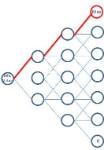***This post has been revised following some input by David Binetti ***
Now that we have looked at the why, what and how of innovation accounting, let’s dig deeper and take a look at one of the most exciting tools to come out of innovation accounting: Innovation options.
What are Innovation Options?
Innovation options, created by the father of innovation accounting, David Binetti, follow a similar principle to financial market options.
In finance, an option is a contract which gives the buyer the right, but not the obligation, to buy or sell an asset or instrument at a specified strike price on or before a specified date. In everyday life, we use the option principle when we buy a life insurance policy.
An innovation option is a financial instrument which lets a potential investor see the maximum market value of a start-up or other innovation project at a specific date in time. It also shows the overall risk of the project. Hence the investor can choose when and how much to invest according to the return/risk ratio he/she is looking for.
Innovations options are meant to be used with disruptive innovation projects. When there is no presumption of success.
How do Innovation Options Work?
 The innovation option model is based on a trinomial tree option pricing formula that is used to calculate financial options values at specific dates.
The innovation option model is based on a trinomial tree option pricing formula that is used to calculate financial options values at specific dates.
Given the formula may scare off even the bravest of us, I will instead direct you to a web page David has gracioulsy put up (http://innovation-options.com/) where you can input your data and the embedded program will make the calculations.
The model calculates every possible value of a start-up or innovation project, at a given date, for three types of outlooks: positive, neutral or negative.
In order to get to the potential values at time x of your project or start-up, you need to input the following data in the model.
Costs
There are two types of costs; your seeding costs, the ones associated with your inital funding needs and the costs associated with taking your company or project to the next level aka the big bet.
Your seeding costs include the funds needed to cover your initial start-up activities in order to test your hypotheses and get to a point where you are reasonably certain you have achieved product/market fit. This can be seen as the premium on the option itself.
The second type of costs are the ones associated with scaling your company or taking your project to the next level (provisioning costs). It could mean going from prototype mode to full blown internal production and/or going from addressing local markets to going after international markets.
Potential
Your start-up or project potential refers to what you think it’s market value will be at the term of the option. There are many ways to estimate this number. It is a function of your revenues, assets and intangibles. It is the answer to What do you think your start-up or project could sell for (after the seeding round or scalling depending on the type of financing you are looking for) in the market?
Time horizon (or option term)
This period is usually defined by the duration of your project or how long you can last given the amount of money you are asking for (aka your runway).
Number of reporting periods
The innovation option framework is based on using some kind of agile, iterative development methodology such as Lean Startup. Hence you need to decide how often you will report the results of your experiments to your investors. These reports should include the type of information you have in your innovation accounting log.
The output of a model, with 3 reporting periods, will look like this:

Each vertical row of values represents a reporting period. In order to get to your startup/project maximum valuation (top right corner), you simply need to see if your experiment results for the period proved your assumptions (you go up), were inconclusive (you go straight), or disproved your assumptions (go down). A scenario where your experiments proved your underlying assumptions for all reporting periods would look like this:

Aside from this graph, the econometric model will also yield the risk sigma (or measurement of the level of risk) of the project. The risk sigma is a comparable measure between projects that is inversely related to the number of reporting periods. In other words, the faster (and more often) you iterate on your market experiments the lesser the overall risk of the project (but the higher the costs as well[1]). If you think about this a bit it’s just common sense. The more often you check in with your potential customers to ensure the product you are working on answers their needs, the higher the probability they will buy it once it’s in the market. You can check out David Binetti’s presentation at the 2015 Lean Startup Conference for additional information on how the innovation option model works.
Why are Innovation Options Game Changers?
 Once the innovation accounting framework is perfected (there are still some subjective parts in the process), it will greatly reduce the commercialisation risk associated with creating disruptive innovations. Entrepreneurs and product creators will have an easier time to get funding. They will also spend their time getting to the knowledge of whether their idea is marketable or not instead of creating spreadsheets with large numbers of unverifiable assumptions.
Once the innovation accounting framework is perfected (there are still some subjective parts in the process), it will greatly reduce the commercialisation risk associated with creating disruptive innovations. Entrepreneurs and product creators will have an easier time to get funding. They will also spend their time getting to the knowledge of whether their idea is marketable or not instead of creating spreadsheets with large numbers of unverifiable assumptions.
Investors will have a framework that reassures them that all is being done to minimise the commercialisation risk of the project. They will also be able to compare the risk of one project to others and pick the ones that fit best with the overall risk/return strategy they have for their portfolio.
Investors will be able to easily put a $ value to any project thus making it possible for companies of all sizes, and not just entrepreneurs, to work internally on disruptive innovation projects.
Finally, one could even see down the road, banks and other more conservative financial institutions getting into innovation financing at earlier stages. This will result in more financing options for entrepreneurs and intrapreneurs thus decreasing the cost of funding a project.
As an end result, it would make disruptive innovations a more mainstream occurrence. This would have a pretty significant impact on our economies and our lives.
What is Needed to Get There
 However, we are not there quite yet. Innovation accounting and innovation options are still in their early, if not embryonic, stages. More guidelines on how experiments are conducted and standards are selected are still needed. This will require more practice and case studies to refine the innovation accounting framework, and possibly, the innovation option formula.
However, we are not there quite yet. Innovation accounting and innovation options are still in their early, if not embryonic, stages. More guidelines on how experiments are conducted and standards are selected are still needed. This will require more practice and case studies to refine the innovation accounting framework, and possibly, the innovation option formula.
Finally, the biggest obstacles to overcome, in the use of innovation accounting and innovation options, are the culture and the required changes in the ecosystems of the financial sector. These sectors have deeply entrenched ways of doing things and are not innovative by nature.
It may just take a Google, Amazon, Intuit or other innovator, outside of the financial sector, to start financing innovations at large and shake things up.
Will innovation accounting and innovation options be the meta disruptive innovations that will bring about profound changes in the creation of disruptive innovations? The potential is there.
[1] Hence, learning how to do your experiments with the least amount of resources (MVP way) will increase the maximum value of your start-up/project.









